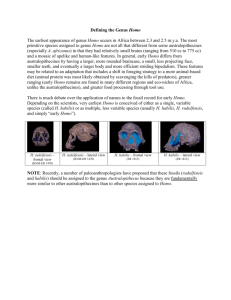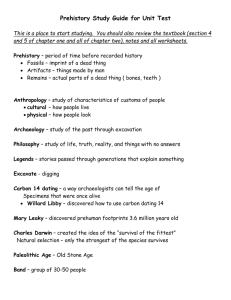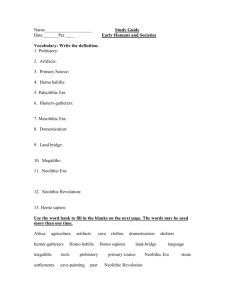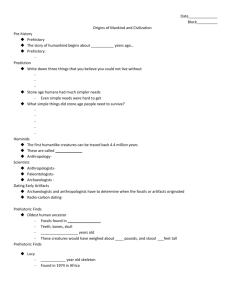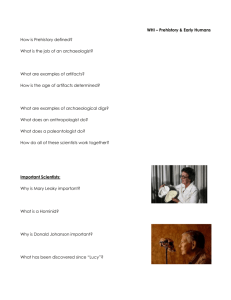Lecture 6.The genus Homo appears. Homo habilis At the end of the
advertisement
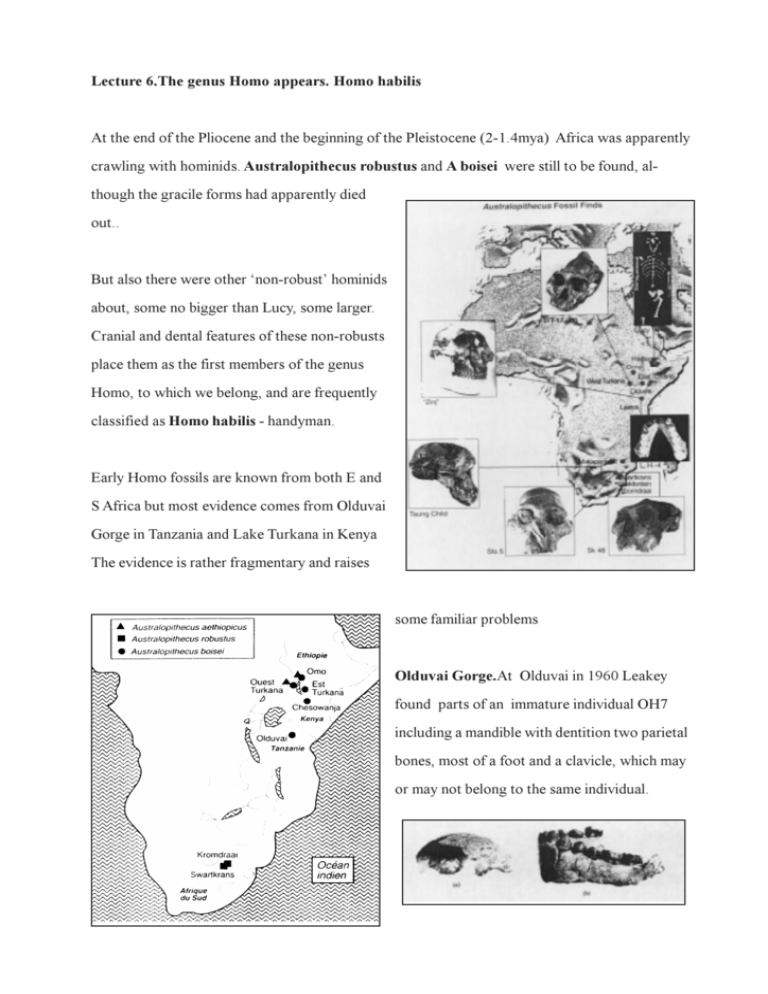
Lecture 6.The genus Homo appears. Homo habilis At the end of the Pliocene and the beginning of the Pleistocene (2-1.4mya) Africa was apparently crawling with hominids. Australopithecus robustus and A boisei were still to be found, although the gracile forms had apparently died out.. But also there were other non-robust hominids about, some no bigger than Lucy, some larger. Cranial and dental features of these non-robusts place them as the first members of the genus Homo, to which we belong, and are frequently classified as Homo habilis - handyman. Early Homo fossils are known from both E and S Africa but most evidence comes from Olduvai Gorge in Tanzania and Lake Turkana in Kenya The evidence is rather fragmentary and raises some familiar problems Olduvai Gorge.At Olduvai in 1960 Leakey found parts of an immature individual OH7 including a mandible with dentition two parietal bones, most of a foot and a clavicle, which may or may not belong to the same individual. The parietal bones are thin, because of their immaturity, but complete enough to give an estimate of cranial capacity of 645ml. This gives a best guess for the adult of 675ml. The mandible is eroded along the lower border, but clearly strongly built. The canine has a slight wear facet which indicates canine overlap. Cheek teeth are to Australopithecine sizes but the premolars are narrow. Third molars had not erupted, giving an age equivalent to a human 12 year old. The hands are powerful with slightly curved phalanges. The joint at the base of the thumb is saddle shaped like ours. The foot bones are rather small, but definitely bipedal, with well developed arches and an adducted big toe. The clavicle is stout, but otherwise like that of a modern man. Three years later another one turned up. OH13 or Cinderella was a little older, with third molars just coming into occlusion and a cranial capacity of 673ml. The Leakeys also recovered bits of George. George (OH16) had been badly trampled by Masai cattle and was in over a hundred bits, but was evidently an adult male with large teeth, a well developed brow ridge and a vault of cranial capacity 638ml. In 1969 Mary Leakey found a remarkably complete cranium (OH24 Twiggy) . This was crushed and distorted but small and lightly built with a cranial capacity of 600ml. OH62 discovered in 1986 had some limb bones: at least some individuals were short and had powerful proportions which resembled Lucy, 1m year older. On the basis of OH7, Cinderella and bits of George Homo habilis was established in 1964: Twiggy and OH62 were assigned to this species when found. Lake Turkana Meanwhile at Lake Turkana hominid fossils were being recovered from the Koobi Fora forma- tion, about 2mya. A large number of fossils turned up here including A. boisei. But alongside these are other animals. KNMER 1813 is a lightly built individual with a thin walled vault and a cranial capacity of around 500ml. The brow ridge (supraorbital torus) is moderately developed and the mid face has limited prognathism. The cheeks are lightly built and the dental arcade parabolic with small teeth. KNMER 1470 in contrast has a cranial capacity of 775ml, less in the way of a supraorbital torus and a very flat face. Precise relationships between parts are a little dodgy because of distortion of the fossil. Other less complete crania are more or less intermediate between these two. There are also many fossil mandibles separated from crania. Some of these are obviously A boisei but others are more lightly built. Wood divided these lightly built mandibles into two distinct groups. Postcranial remains include at least four partial skeletons and many fragmentary long bones, especially femora. These have not been fully analysed, but two part skeletons are believed to be Homo habilis. One of these ER3735 includes some skull parts, which look like ER1813 and parts of an arm and leg. The forearm is similar in size to a chimp, with powerful shoulder muscle markings and strong flexion at elbow and digits that suggest climbing ability. This is much larger than Lucys forelimb, but hind limbs are nearly equal. There are also bits of boyisei in these remains, and other fossils given various names. South Africa Early Homo material is also known from the Transvaal. Again these crop up in the same deposits as Australopithecus These animals (SLIDE) however are distinct and very like some of the Olduvai material. Stw 53, the most complete skull recovered, for example closely resembles OH24, Twiggy, but with slightly more robust muscle markings. So what do we make of Homo habilis? In the announcement of habilis Leakey was doing something rather more profound than just setting up a new species: he was redefining Homo as well. Leakey argued that Homo should be defined not narrowly on one or two particular features but broadly on overall features. Man, he said, has truncal erectness, bipedal locomotion and precise manipulation even if these occur with a cranial capacity of 600ml (previous thought was that about 750ml was need to qualify as a human brain). Individual early Homo brains may thus overlap with Australopithecus but the average human brain would be larger than the average Australopithecine, absolutely and in relation to body size. Muscle markings could be weak or strongly developed, the face flat or projecting but not dished. Teeth should be set in an even curve and the molars smaller than in Australopithecus and incisors and canines should be large relative to cheek teeth. The teeth in Homo are also generally narrower. Both the revised genus and the new species were criticised at the time, but more recent finds have confirmed these ideas. The brain of H habilis is now seen to be more human than Australopithicine in proportions and the latest estimates of 640ml put it 25-40% bigger. Later finds also confirm the smaller molars with thinner enamel: the jaw musculature and tooth wear is reduced, and the smaller jaws and teeth suggest a head balanced on the spine in a more human fashion. Diversity in early Homo The overall problem that we have with habilis, once we have decided that he is not an Australopithicine, is the diversity of the fossils. In the Olduvai material this was interpreted by Leakey as diversification towards two later types of man H.erectus (who we havent yet met) and H. sapiens. Others suggested that later material was more advanced (although the time scale means that evolution was going at a fair old whack). If in doubt, blame it on sexual dimorphism as usual was also used. The problem was made worse when the Lake Turkana finds were added, because they increased the sample size without decreasing the variability - in fact they tended to increase it. After a period in which specimens were either attributed to Australopithecus, or to Homo but without a species or just left to gather dust while we had a think some conclusions started to emerge. One obvious split was between 1813 lookalikes and 1470 lookalikes, with other fossils placed in one or other group. Were they species or were they sexes? The differences in cranial capacity between these two are so great that if they were due to sexual dimorphism it would have to be more marked than that seen in Gorilla, which holds the prize at the moment. So how about two species? The technique that you use in Practical 3 allows us to distinguish between size related shape change (i.e. the change in shape that is consequent on growth) and non-size related shape change. If you do this on early Homo fossils you find that they have lots of both kinds of shape change, well in excess of sexual dimorphism again, so it was proposed that two species were present. One of these, less variable than the other, with thinner vault, smaller parietals, a U shaped dental arch and smaller jaws was considered to be H habilis, and the rest were Homo sp. Later workers have split Homo sp. into four distinct groups. This was not too popular for obvious reasons, and many authorities now consider Homo sp to be Homo rudolfensis (Lake Rudolph was the old name for Lake Turkana). Phylogeny So here at the border of the new genus Homo and the old Australopithecus we see arguments at two levels. First was Homo habilis Homo or Australopithecus and secondly is Homo habilis one group, or two or more? As on all borders there are disputes. In the main Leakeys arguments have prevailed, and these fossils are seen as Homo, with occasional skirmishes about individual fossils: this is bound to happen in a mixed deposit of variable individuals. Putting all known habilis fossils into one group is certainly the simplest alternative. But if we do this we run the risk of not recognising significant differences in the material. There is also a risk of habilis becoming a dumping ground for all sorts of bits and pieces of rock that dont quite fit elsewhere. And there is the gut feeling, or the opinion based on other living and fossil primates that there is simply too much variation in this group of fossils to represent one species. The other view, that there are two species, seems to be a more reasonable approach: more than two species adds even more complication. If we believe in one species of habilis how do we see the phylogeny? Tobias, the main proponent of this view suggests that A africanus is a common ancestor of both a robust Australopithecine and H habilis. The robust clade had bigger teeth and jaws, the habilis went the other way, with smaller jaws and more brain power. If we start from two groups of habilis instead of one then Stringer found the 1470 group more primitive than the 1813 while Woods latest analysis finds them to be sister groups. We can summarise the main points of this argument 1. The earliest Homo material is so variable that it is likely to represent more than one species 2. Craniofacial data shows differences between habilis and rudolfensis. Rudolfensis seems to parallel robust Australopithicines. 3. Postcranial remains associated with habilis show that it had a primitive, Australopithecine-like postcranial skeleton. If the postcranial bits of rudolfensis are in fact rudolfensis (and there is doubt) then rudolfensis had a postcranial skeleton much more like Homo. 4. This is confusing : an advanced head on a primitive body or vice versa? Neither is necessarily ancestral to man. 5. Two animals so different have probably not had a recent common ancestor. Behaviour Another interesting factor enters the fossil record at this point: we begin to find artefacts, tools at both Olduvai and Lake Turkana. These tools are generally regarded as made and used by Homo although they could be Australopithecus: but at no site are tools and Australopithecus found together without Homo. The earliest tools we know of are from the Omo valley in Ethiopia. These are sharp quartz flakes struck from quartz pebbles. Signs of use (i.e. wear) are rare. They are flakes of quartz and small cobbles from which flakes have been struck. Retouching and signs of wear are still rare and the earliest tools are from a thin strata, implying transient occupation; sometimes there are repeats suggesting periodic occupation of a site. all occur on river edges, close to cover. Oldawan or pebble tool assemblages are slightly more advanced. The cores may be pounders or choppers, but it seems more likely that they are simply cores used to produce flakes. Flakes are very effective in cutting hide and disarticulating joints. The tool sites may represent caches in the landscape deposited perhaps for future use. This implies selectivity and foresight. This use of tools is often associated with a fancied increase in meat eating, though whether cause or effect is open to doubt. Oldawan tools show no evidence of style or design. They were probably a response to one off need. However the ability to make them implies a knowledge of stone structure and behaviour which exceeds that of all modern apes. No chimp or gorilla flakes stones in the wild: but an Orang utan has been taught to do so in captivity. Some Olduvai tools have been made from stones not present in the area and brought in from several kilometres away. Was the implied cleverness of the early Homo reflected in the structure of his brain? Endocasts show that the brain was bigger in habilis, and that the enlargement was in the frontal and parietal areas. The sulci and gyri here resemble those of later man, and the speech areas are particularly prominent. The characteristic left right dominance is also present. But then we said both these factors were present in Australopithecus, so its not too surprising. Some experts see a linkage between tool making and speech via increasingly complex social behaviour. How did these animals move? Well there is good evidence to show that they were bipedal, but in the small ones especially the arms were very long in relation to the legs. The hind limbs however are more modern than those of Australopithecus. We should beware of thinking of Homo habilis as the great hunter however. They were not all that large and we have no evidence to support organised hunting. In primitive hunter/gatherer societies which survive today meat eating is usually associated with scavenging. There are tool marks on bones from Olduvai, but they are always superimposed on carnivore tooth marks. So they could be scavenging or extracting marrow from discarded carnivore kills. Habilis probably didnt have fire: uncooked meat is very tough given smallish teeth and jaws. So how did they live? The classic idea of habilis society probably relies too heavily on human parallels, with sexual division of labour and much male camaraderie resulting from co-operative hunting. Lets start from something more concrete. Food availability in this habitat was clearly spasmodic and uncertain as well as varied. Food sharing behaviour would clearly be an advantage in these circumstances, perhaps leading to provisioning of home bases, and perhaps the use of tools to make food containers. Think of the tremendous selective advantage of a bag in these circumstances. We can also hypothesise that increasing brain size is linked with slower maturation and extended parental dependence. This might lead to a need for better offspring survival and perhaps to separate feeding ranges for males and females to avoid competition with the kids. Pair bonding would help too: if males feed females and infants as well as themselves the interval between pregnancies can be reduced. But there are problems with this model: it posits human behaviour where none necessarily exists. Monogamous pair bonding correlates with reduced sexual dimorphism and habilis was markedly dimorphic. How do we know that the growth period was long? There arent enough good fossils of habilis, but we know that in Australopithecus the growth period was rather short. Perhaps habilis roamed around in large mixed sex groups with females bonding with individual males high in the pecking order (hence dimorphism) Perhaps again the divergence between Homo and robustus, or even between habilis and rudolfensis was due to diet. Robust forms could go for widespread, plentiful low grade food which they ground through in great quantities . More lightly built types could go for larger high quality items like meat, which would be in short, unpredictable supply and perhaps needed more wit to find. This would need better male female co-operation and perhaps leads towards monogamy and infant protection.


